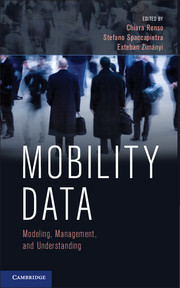Book contents
- Frontmatter
- Contents
- List of Contributors
- Preface
- Acknowledgments
- PART I MOBILITY DATA MODELING AND REPRESENTATION
- PART II MOBILITY DATA UNDERSTANDING
- 6 Mobility Data Mining
- 7 Understanding Human Mobility Using Mobility Data Mining
- 8 Visual Analytics of Movement: A Rich Palette of Techniques to Enable Understanding
- 9 Mobility Data and Privacy
- PART III MOBILITY APPLICATIONS
- PART IV FUTURE CHALLENGES AND CONCLUSIONS
- Bibliography
- Glossary
- Author Index
- Subject Index
- Plate section
9 - Mobility Data and Privacy
from PART II - MOBILITY DATA UNDERSTANDING
Published online by Cambridge University Press: 05 October 2013
- Frontmatter
- Contents
- List of Contributors
- Preface
- Acknowledgments
- PART I MOBILITY DATA MODELING AND REPRESENTATION
- PART II MOBILITY DATA UNDERSTANDING
- 6 Mobility Data Mining
- 7 Understanding Human Mobility Using Mobility Data Mining
- 8 Visual Analytics of Movement: A Rich Palette of Techniques to Enable Understanding
- 9 Mobility Data and Privacy
- PART III MOBILITY APPLICATIONS
- PART IV FUTURE CHALLENGES AND CONCLUSIONS
- Bibliography
- Glossary
- Author Index
- Subject Index
- Plate section
Summary
Introduction
Mobility data represent an invaluable source of information that can be recorded thanks to mobile telecommunications and ubiquitous computing where the locations of mobile users are continuously sensed. However, the collection, storage, and sharing of these movement data sets raise serious privacy concerns. In fact, position data may reveal the mobility behavior of the people: where they are going, where they live, where they work, their religion and so on. All this information refers to the private personal sphere of a person and therefore the analysis of mobility data may potentially reveal many facets of his or her private life. As a consequence, these kinds of data have to be considered personal information to be protected against undesirable and unlawful disclosure.
In the specific case of mobility scenarios, there exist two major different contexts in which the location privacy problem has to be taken into consideration: online location-based services and offline data analysis context. In the first case, a user communicates to a service provider his or her location to receive on-the-fly a specific service. An example of LBS is find the closest point of interest (POI), where a POI could be a restaurant. Privacy issues in the context of online location-based services have been already addressed in Chapter 2. In the second case, large amounts of mobility data are collected and can be used for offline data mining analysis able to extract reliable knowledge useful to understand and manage intelligent transportation, urban planning, and sustainable mobility, as already highlighted in previous chapters.
- Type
- Chapter
- Information
- Mobility DataModeling, Management, and Understanding, pp. 174 - 194Publisher: Cambridge University PressPrint publication year: 2013
- 3
- Cited by

